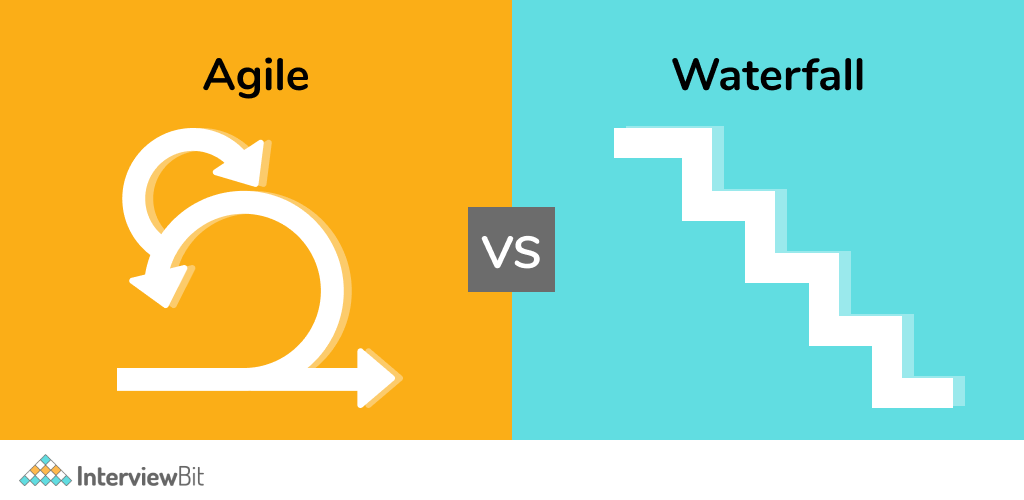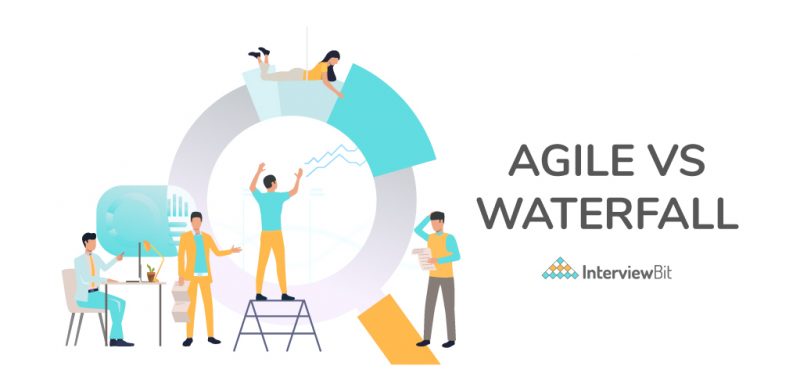In today’s modern software development business, the two most important and popular approaches to project management are:
- Waterfall – This is a traditional software development approach.
- Agile – is a type of Rapid Application Development that falls into a certain category. It predates Waterfall (the 2000s) and was used in conjunction with Kanban or Scrum.
Even though both software development methods are reliable and serve the same purpose of determining the best feasible strategy to completing a project in the shortest period, they do their tasks in completely different ways.
To guarantee a high-quality final result, software projects adhere to a method of well-defined processes called the development life cycle (SDLC). An SDLC outlines phases and the orderly transition from one phase to the next.
Confused about your next job?
Continue reading to learn more about the differences between Agile and Waterfall.
- What Is Agile?
- What is a Waterfall?
- Key Differences
- Agile Vs Waterfall
- Agile or Waterfall: Which is Better?
- Conclusion
- Frequently Asked Questions
- Q1: Why is Agile preferred over Waterfall?
- Q.2: Does Agile cost more than Waterfall?
- Q.3: Is the waterfall model costly?
- Q.4: Why is Agile needed?
- Q.5: How to choose between Agile and Waterfall?
- Additional Resources
What Is Agile?

Agile methodology is a strategy that aids in the software development process by allowing for continuous iteration of development and testing. Unlike the Waterfall approach, development and testing are done simultaneously under this methodology. This method helps consumers, developers, managers, and testers to communicate more effectively.
Pros of the Agile Model
- It is a method that is centred on the customer. As a consequence, the customer is always involved throughout the entire process.
- Agile teams are extremely active and self, and as a consequence, they are much more inclined to deliver superior results in development projects.
- The agile software development approach ensures that development quality is maintained throughout the development process.
- The strategy is solely based on the notion of incremental consistent growth in progress. As a consequence, both the customer and the crew are informed of what has and has not been accomplished. As a consequence, the risk of the development phase is minimized.
Cons of the Agile Model
- It is not a viable strategy for small-scale development efforts.
- To try and make crucial choices during the meeting, it is vital to have a professional presentation.
- The cost of implementing an agile approach is just somewhat greater when compared to traditional development approaches.
- If the project manager isn’t clear on the end goal, the project might easily become derailed.
What is a Waterfall?

The Waterfall Methodology was the first to be designed and deployed as a Process Model. Another name for this kind of model is a straightforward life cycle model. It is very easy to understand and use. In a waterfall methodology, each phase of work must be completed before moving on to the next phase, and there is no crossover between the phases in this model.
The first SDLC method used in software design was the Waterfall model. It was first released in 1989.
The waterfall model portrays the software development life cycle as a sequential, linear flow of information. This implies that any stage in the development phase may begin only once the previous phase has been completed. This waterfall model’s stages do not cross in any manner.
Pros of the Waterfall model
- It is among the most simple types to operate. Because of the project’s nature, each phase contains deliverables and also a review process.
- It is best suitable for smaller tasks with defined requirements that are simple to understand and execute.
- completion of the job in a shorter amount of time
- Both the procedure and the outcomes are meticulously recorded.
- Simple to adopt a method for restructuring teams
- This project management approach is useful for dealing with dependencies.
Cons of Waterfall Model
- This is not the preferred product for a big project.
- This approach is less effective if the requirement is not clearly defined at the start.
- It is difficult to travel ahead and make changes to previous stages.
- The testing step starts after the design phase is finished. As a result, there is a high probability that flaws will be found required during the development process when they will be more costly to repair.
Key Differences
Waterfall refers to a linear sequential life cycle model, whereas Agile refers to the development process as an up sequence of development and testing. Waterfall is a regimented software development approach, while Agile is a dynamic software development strategy. When comparing Waterfall vs. Agile, remember that Agile is an iterative time taking design process, while Waterfall is a linear process. Waterfall examines after the “Build” phase, while Agile tests during software development. Agile allows for adjustments to project requirements, while Waterfall does not allow for modifications of the requirements once the project is in progress.
Agile Vs Waterfall

Below is the difference between Agile and Waterfall software models in the tabular form for better understanding:
| Agile | Waterfall |
| Sprints are used to break down the project into manageable pieces. | In general, the methodology gets separated into several stages. |
| Agile models follow the concept of consistent growth during the project itself so that afterwards it reduces the risk of completing the requirements. | The waterfall technique is a sequential design process. |
| The model is known for its versatility. | This methodology is a systematic development method that may be rather rigorous at times. |
| Agile may be thought to be a compilation of several outlines. | In this, the software gets developed as a specific outline. |
| This method is flexible and allows changes for the progress of the project soon after the first stage of designing gets completed. | Once the project development begins, there is no way to change the specifications if any are required. |
| Because this method uses an incremental development approach, the phases of design, production, testing, and other project management may appear several times. | All the development phases of the project are accomplished once |
| Testing is frequently done in conjunction with the development phase in the Agile model to maintain consistent quality. | In this method, the test approach is rarely used. |
| This method is a software advancement technique in which you can change or develop the demands over time. | Appropriate for specialized requirements and unforeseen changes. |
| Testing occurs with software development simultaneously. | The “Testing” is done after the “Build” step. |
| It gives a production attitude wherein the software product fulfils the demands and adapts to the customer’s expectations | It is entirely focused on completing the project. |
| It goes perfectly with Duration and Resources or non-fixed finance. | By obtaining a risk agreement at the start of the process, it is possible to reduce risk in firm-fixed-price contracts. |
| It is preferable to work with small, focused teams with a higher level of cooperation. | A team’s capacity to coordinate and synchronize is severely restricted. |
| The product manager and his colleagues prepare a list of lacks every day for the development of a project. | In this, the Business analyst develops the specifications before the beginning of a project. |
Agile or Waterfall: Which is Better?
So, how should you choose between Agile and Waterfall? It is determined by the project. Your company and your initiatives will thrive if you choose the correct technique for the right work and the right people. Consider the following factors before deciding on a technique:
- What kind of work do we do?
- Who is going to do the work?
These factors are essential considerations when deciding on either approach. When providing breakthrough work with a specified timeline, the waterfall approach is beneficial. The Agile approach works effectively when groups are semi-permanent and continuous supply and cross-team alignments are essential.
Consider your goals and check if either of the approaches can help you to fulfil your project.
Conclusion
While the waterfall method is useful for specific tasks, Agile works effectively for processes that involve continuous delivery. Continuing projects allow teams to learn about their roles and what they can perform in a variety of jobs. Furthermore, unravelling into iterative portions enables speedier feedback loops, permitting your service to be readily modified to reflect client preferences. It is critical to realize that there is still no one-size-fits-all solution for job management.
We hope this essay on agile vs. waterfall has helped you comprehend both concepts.
Frequently Asked Questions
Q1: Why is Agile preferred over Waterfall?
Ans: Agile is preferred over Waterfall for a few reasons:
- Waterfall projects are generally more expensive and take longer to complete. Agile projects are typically less expensive and may be completed fast.
- Because faults and modifications are detected in the early phases of a project, agile project management results in considerably less rework.
- According to studies, 49 per cent of Agile projects are successful due to Agile’s adaptive and customer-first strategy. In Waterfall, however, this proportion is limited to 14 per cent.
Q.2: Does Agile cost more than Waterfall?
Ans: Agile is not more expensive than Waterfall. It may drastically save expenses by removing needless waste and accelerating development.
Q.3: Is the waterfall model costly?
Ans: The Waterfall methodology is more expensive. Even though stakeholders are certain of their demands, which leads to an increase in the cost.
Q.4: Why is Agile needed?
Ans: Agile fosters empowerment, responsibility, a variety of ideas, early benefit release, and continual improvement. It enables early decision testing and rejection, which is not possible in the waterfall.
Q.5: How to choose between Agile and Waterfall?
Ans: Waterfall is more predictable if the project schedule is fixed. Agile is the right choice when speed is more essential than documentation and method.







 Join WhatsApp Group
Join WhatsApp Group


